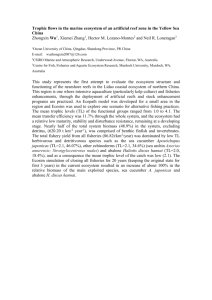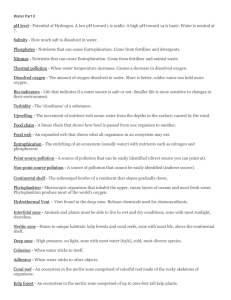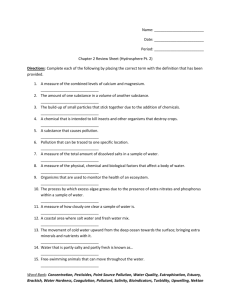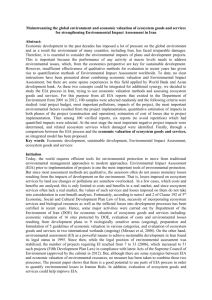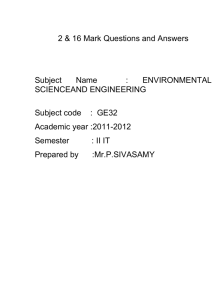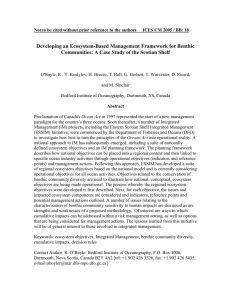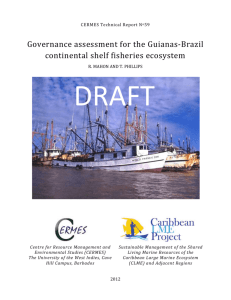SESSION 5: Environmental and Sustainable Development Aspects
advertisement
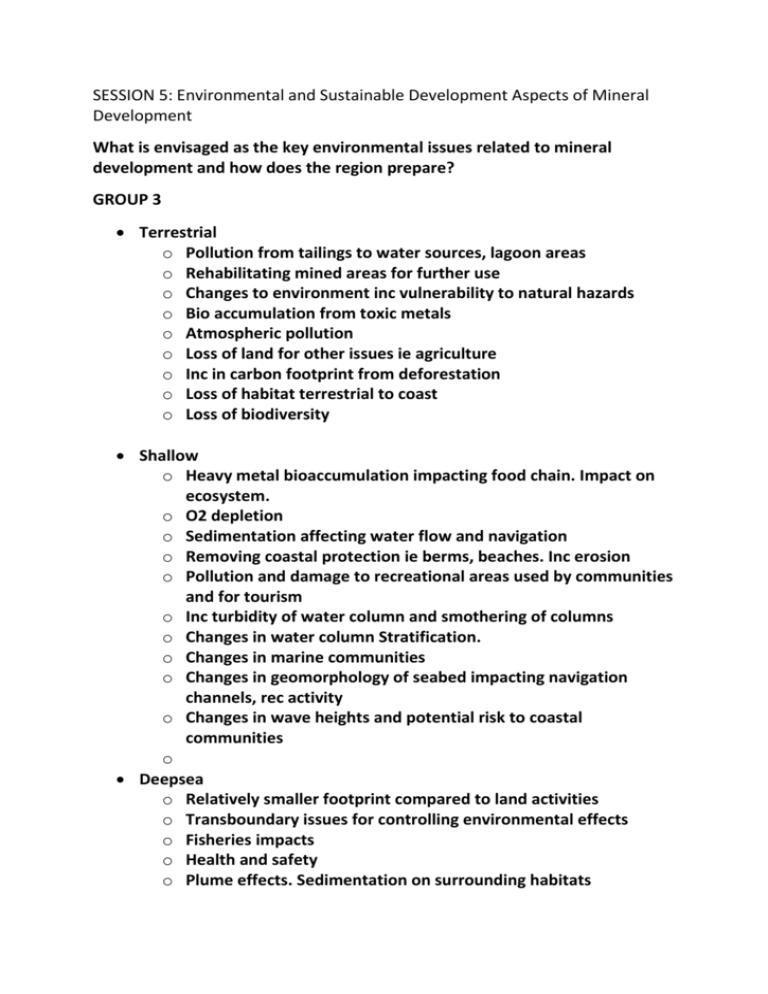
SESSION 5: Environmental and Sustainable Development Aspects of Mineral Development What is envisaged as the key environmental issues related to mineral development and how does the region prepare? GROUP 3 Terrestrial o Pollution from tailings to water sources, lagoon areas o Rehabilitating mined areas for further use o Changes to environment inc vulnerability to natural hazards o Bio accumulation from toxic metals o Atmospheric pollution o Loss of land for other issues ie agriculture o Inc in carbon footprint from deforestation o Loss of habitat terrestrial to coast o Loss of biodiversity Shallow o Heavy metal bioaccumulation impacting food chain. Impact on ecosystem. o O2 depletion o Sedimentation affecting water flow and navigation o Removing coastal protection ie berms, beaches. Inc erosion o Pollution and damage to recreational areas used by communities and for tourism o Inc turbidity of water column and smothering of columns o Changes in water column Stratification. o Changes in marine communities o Changes in geomorphology of seabed impacting navigation channels, rec activity o Changes in wave heights and potential risk to coastal communities o Deepsea o Relatively smaller footprint compared to land activities o Transboundary issues for controlling environmental effects o Fisheries impacts o Health and safety o Plume effects. Sedimentation on surrounding habitats o o o o o o o Pollution from ships Treatment of sewerage Toxicity issues re: SMS for non-vent fauna Changes in community (animals) Loss of species Slow recovery rates once deep sea disturbances to nat. equil. Ships atmospheric pollution Region address issues Replanting trees in affected areas Develop mitigation strategies as part of EIA process. Eg faunal relocation/ artificial habitats Developing regulatory frameworks Setting up protected areas/ set aside areas Communicating environmental effects Use precautionary principles to developing resource. Long term monitoring programme Need for Baseline studies and EIA Establish clear management objectives Literature review to establish knowns and unknowns GROUP 2 Destruction of biological communities and ecological system Deforestation Waste Air pollution Acid in the water Tailings placement Carbon footprint Treatment to endangered species Water system in rivers polluting Living org in water Deep sea fauna threatened Region to prepare EIA to be carried out Environmental Acts to be revised/developed Environmental Policies and Regulations in place Environmental Management Plans Baseline studies carried out Governance structures and mechanisms established Legislative framework Education and awareness plans in place Cultural and social preparedness Capacity development in key roles at regional and national Knowledge gaps Monitoring GROUP 1. Focus on DSM. 3 strata Surface, Pelagic and Benthic Fisheries Change in chemical composition Turbidity Environment Impact on benthic environment and ecosystem Sediment plumes within the water level Transboundary sediment transportation Potential concerns relating to oil spills Preparation - Regional approach involving PICTs Baseline studies of Surface, Pelagic and Benthic environments Build capacity within the region to train environmentalists and scientists Undertaking regional skills programme Create a proper zone to ensure that the ecosystem can continue to produce. Information sharing on how ecosystem and environment responds to DSM activities Plans to inform all stakeholders. TRANSPARENCY. Engagement with communities. Containment plan for potential oil spills. DM plan in place More marine minerals surveys. Improved technologies Environment Assessment Plan in place Build a multipurpose ship for DSM, data collection, fisheries and monitoring plus any related activities GENERAL COMMENTS Any minerals exploration will incur environmental impacts. Aim to minimize the impacts. ‘Acceptable level of damage’ Early spatial management to ensure there are large areas where mining will not occur given that science cannot provide answers on potential impacts in the short term. Robust risk management framework to understand risk and uncertainties in progressing exploration. Opportunities through Geohab to be better understand interactions between deep sea fauna and the deep sea environment Regional DSM agreement (similar to Fisheries agreement) s


